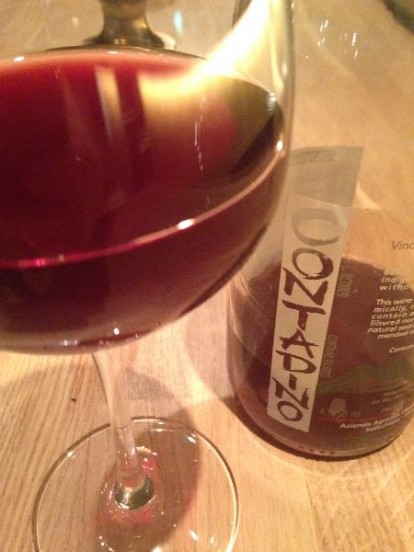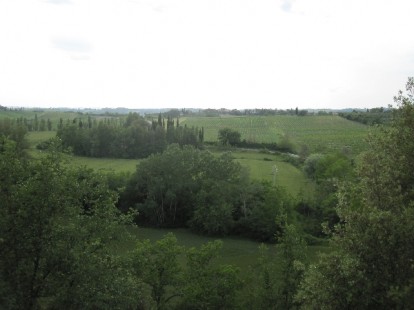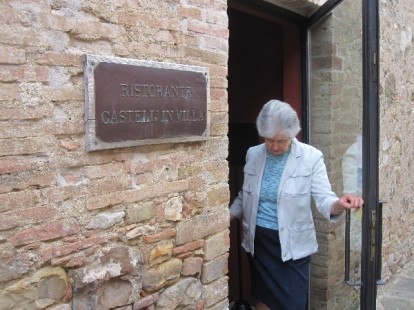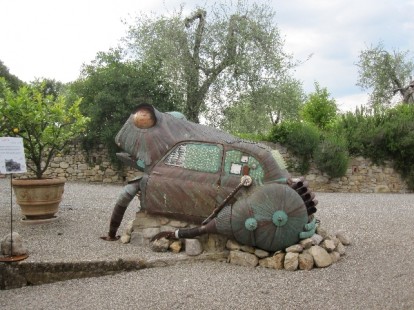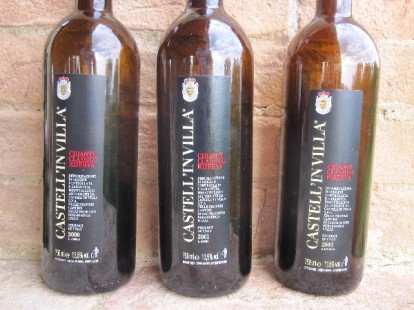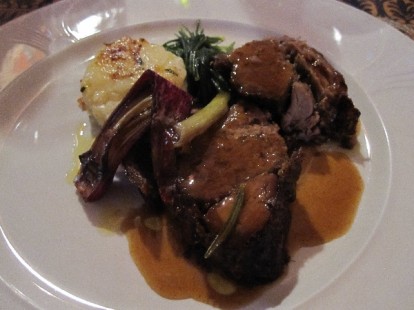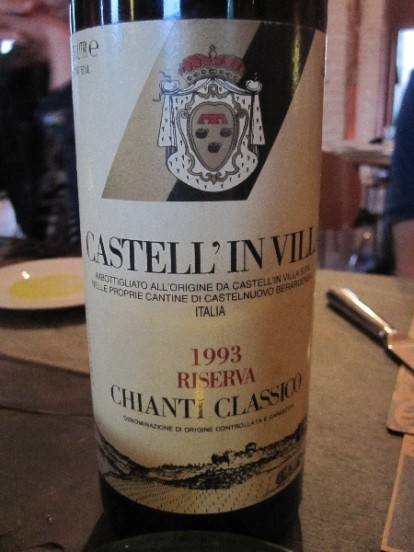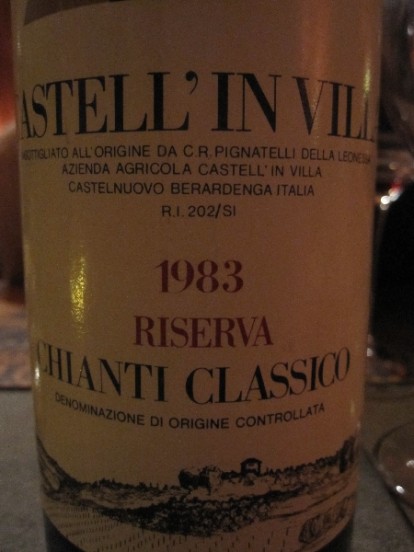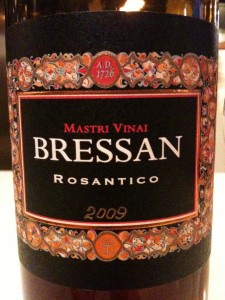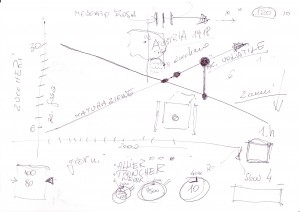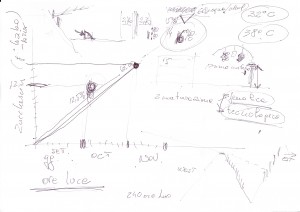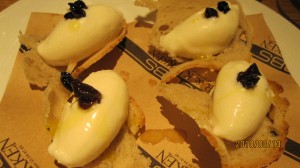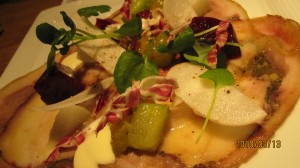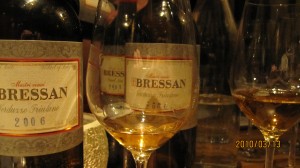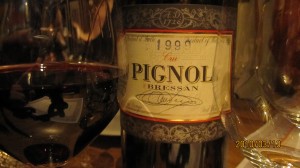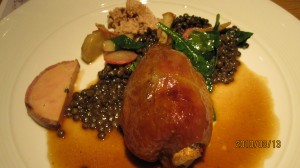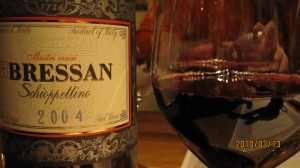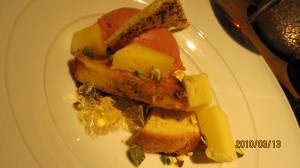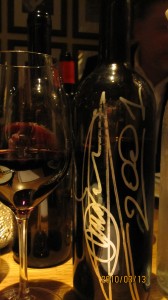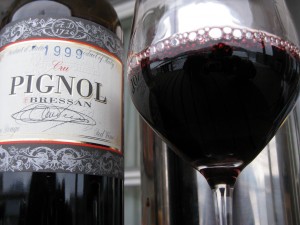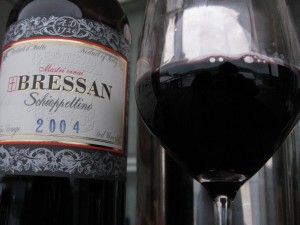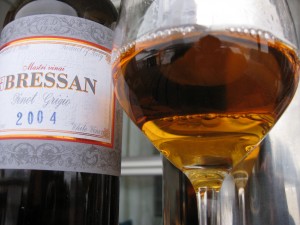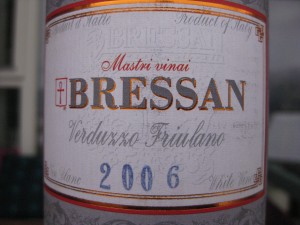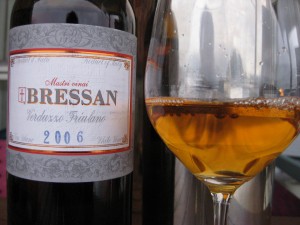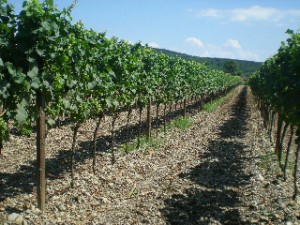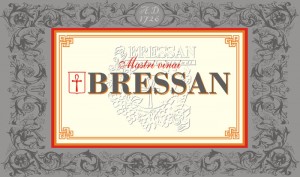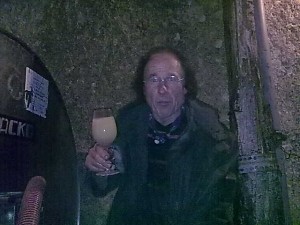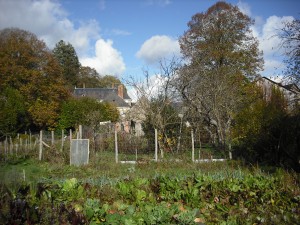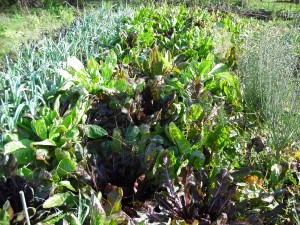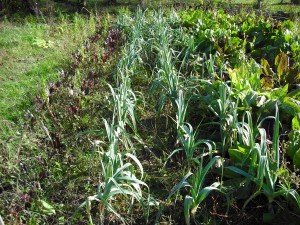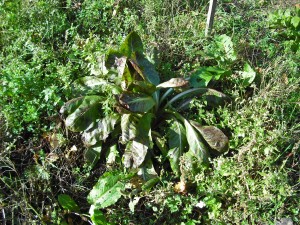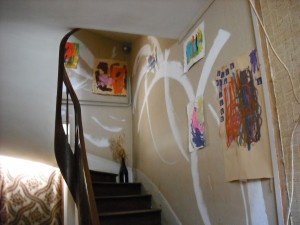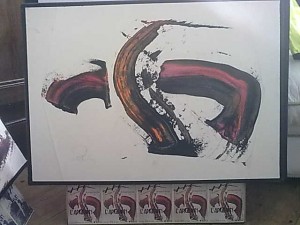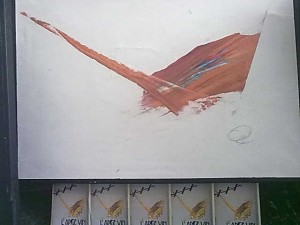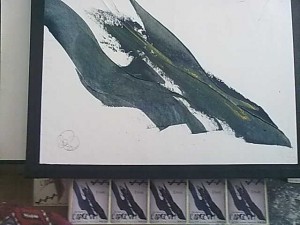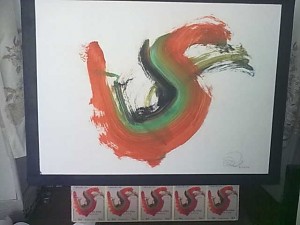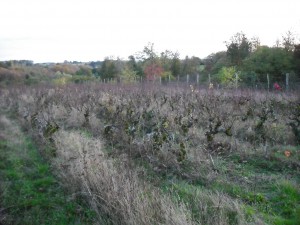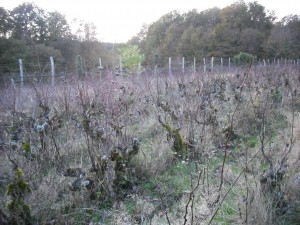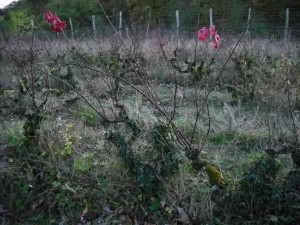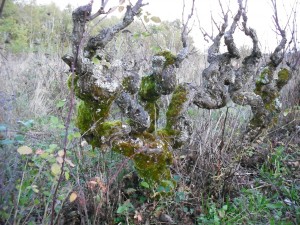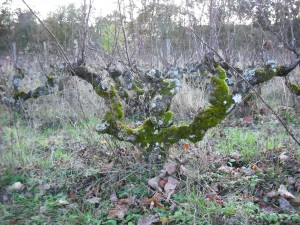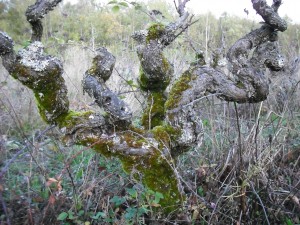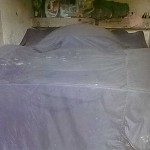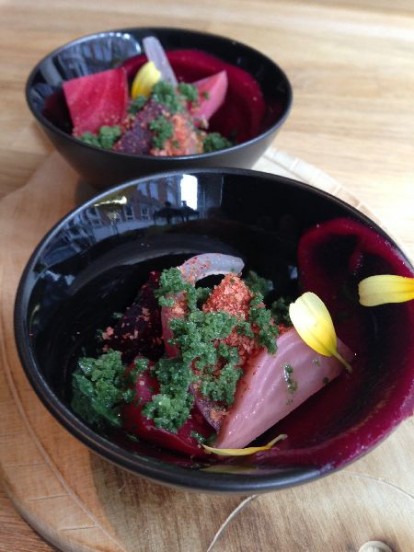
Since it’s fall and root vegetables are in season now, I thought I would take this time to finally, after a quiet year (of not updating much), get back to my roots.
So here are two visuals of what I consider back to roots that stimulate me. Beet roots and Rosso del Contadino. Both come from the land and from nature. Both are natural. both are delicious
The Contadino 9 continues Cornelissen’s drive to create the best wine he can from the grapes that nature gives him. Thanks to Frank’s careful attention to not disturb nature, she gives him healthy grapes. But if it wasn’t for his intellect and expertise, the wines would not be as wonderful as they are. Because I know, and especially he knows, and despite what many winemakers say, wine IS NOT made in the vineyards. The raw materials come from the vines, but knowing when to harvest the grapes and what to do next can only be decided on by the winemaker.
This is why Frank’s wines taste of the volcano. Deep, salty and bloody. They come from a place that is undisturbed by humanity and they taste that way. So, with all the respect that is due you Frank, thank you. Thank you for understanding nature and how to take what she gives you and produce some of the most compelling wines I have ever tasted.
]]>In total, the Castel’in Villa estate encompasses about 300 ha on which she produces wine, a very nice olive oil, runs a charming agriturismo, and a great restaurant. The restaurant makes all the food fresh on site, and many of the ingredients are sourced locally, like the herbs, wild pig and the pheasant. Coralia is also an appreciator of eclectic art and some unusual sculptures can be seen on her property. Although she is approaching 75 years of age, he demeanor and looks deceive that age, as she socializes with a glass of wine with you until late into the evening. Always poised and elegant yet never arrogant. A certain sense of calm emanates from her that is both charming and contagious.
Castell’in Villa work very traditionally both in the vineyards and in the cellar and her vineyards are very much alive with wild pigs and pheasants (which you can hear quite clearly throughout the day & night). The wines ferment spontaneously, except in extreme vintages where a neutral yeast might be added to commence fermentation. If I heard correctly, they have only had to induce fermentation once in the most recent years. Maturation in large Slovenian botti give these Chianti’s a very traditional feel even though they are 100% Sangiovese, which until recently was not allowed under the legislation. It was customary to blend in some other local red grapes and even some white grapes. I would like to note that I overheard Coralia saying she had just purchased some new French botti so it will be interesting to see how this affects the future vintages.
I wasn’t much of a Chianti fan until I had tasted some older vintages a few years ago and I recommend to do your best to taste an older vintage to really appreciate a Chianti. On this recent visit to Castell’in Villa, I got to taste the following wines (in order of vintage from youngest to oldest):
2006 Chianti Classico Riserva – (not yet for sale) Tight and a bit closed. Very serious. Concentrated and young and one of the only wines I tasted that showed hints of dark fruit. Rough and young tannins. Hints of spice. Yet remaining fresh. Really a storage wine.
2003 Chianti Classico Riserva – very open, but at first appearing a bit overripe and representative of the 2003 warm vintage. Only 10 min in the glass and the wine opened to reveal bright red fruit and spice with hints of smoke. Nicely integrated oak. Became very fresh and drinkable with very refreshing acidity. I enjoyed this vintage tremendously.
2001 Chianti Classico Riserva – A more classic & reserved nose with less development snowing than the ’03 even though it was two years older. Less raspberry and more cherries. More classic and typical Italian nose. A youthful nose with hints of balsamic evolution. Roses and rose hips. On the palate, cherries and cherry pips. More restrained than the ’03 yet more structured and serious at the same time. Surprisingly young considering it’s 10+ years. Nicely integrated oak. More tannic also than the ’03. In my opinion this wine needs 8-10 more years to really show its stuff. The ’03 is more drinkable and refreshing and easier to drink (quickly).
*The ’01 you talk about and the ’03 you drink
2000 Chianti Classico Riserva – another warm vintage. Nose – more serious again then the ’03 but showing more evolution than the ’01. Mineral with cherries. Feels more mineral than ’01. Very open and floral with hints of balsamic, but only hints. Feels a bit more alcoholic than the other two vintages. Fresh but somehow a bit more austere than the previous two. The alcohol sits a bit in the back of the throat. Some nutty hints on the nose, which I don’t mind. Not as fresh as the others with some acidity which pokes a bit making it a bit more challenging to drink on it’s own. The least drinkable so far. Not sure this wine has potential to improve in the cellar. It seems the fruit is more evolved than the structure. Medium tannins. Spiky, edgy and not so balanced in my opinion.
1993 Chianti Classico Riserva – evolved on the nose. Stewed cherries and hints of balsamic. On the palate still very much alive and vibrant with vivid acidity. Notes of lavender fill the glass and my nose. Very enjoyable
1983 Chianti Classico Riserva – surprisingly quite closed initially. Very timid on the nose. Balsamic notes. As it opens, it feels more serious and sure of himself even than the 1993. Hints of licorice. On the palate the wine is quite open and focused with sweet tannins and fresh acidity. More herbaceous and spicy than the 1993. Sweet ripe fruit, raisins. Still very focused with really sweet fruit. Honestly, still a young wine with many years to go.
2008 Chianti Classico – fresh and expressive. Sour cherries, refreshing and light. Long with medium tannins. Good alcohol integration. The nose is wide open. Fresh and vibrant. Long.
2008 Chianti Classico Riserva Poggio Delle Rose – Some dark fruits. Very structured and oak is a bit evident, but not dominant. Darker fruits then the other wines. Stronger tannins from both the fruit and wood. A bit earthier than the others, you can taste the soil in the wine. Summed up, this wine has fantastic fruit and concentration. However, not my style of wine.
1995 Vin Santo – fresh and light and with such great, ripe acidity that the wine finishes dry. Sultana’s and nut’s. “Amabile ma secco” (fruity/sweet but dry). “Lascia la bocca pulita con un bel ricordo” (leaves the palate clean with a nice memory/souvenir)
]]>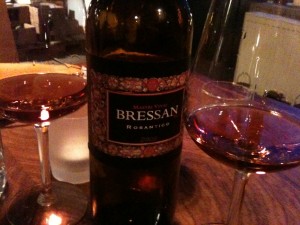
The Moscato Rosa vine has an ancient history dating back to the Austro-Hungarian Empire here in Friuli, hence the clever name on the label. Fulvio Bressan’s family have always had this small (1 HA) vineyard, and Fulvio’s father used to make a sweet wine from the vine, the traditional vinification method for this grape. A rather rich history for this rather difficult little vineyard.
The vineyard had an extremely low yield of about 1500 liters in 2009 for the 1 HA, that’s about 2000 bottles. And that was in a good year. Bressan picks the grapes late to insure ripeness, which is tricky since this grape has a high level of “colatura” or risk of falling off the vine when ripe. But still he waits to pick the grapes late so that they are dry like sultana’s, adding to the risk that botrytis cinerea (noble rot) will set in, which is not desired here. Add these risks together and you have the elements of total vintage loss, which is what happened in the previous 7 vintages! Also no wine was made in 2010 and the 2011 is still in tank fermenting
After the manual harvest, the grapes were pressed and de-stalked. Maceration was for 3 days, fermentation was spontaneous thanks to the ambient yeasts present on the bunches. Alcoholic fermentation lasted for about 4 weeks, followed by an induced (by a small increase in temperature) malolactic fermentation. The wine was then racked and left on the fine lees in stainless steel for two years, giving the grape the chance to show its elegance and personality. The wine was then bottled without filtration. The wine then continued for a bit longer for some bottle maturation. Total alcohol is 13.20% and total acidity is a fresh 6,38 g/l.
Click here for some nerdy information for those who care.
Date tasted: March 3rd, 2012 18:30
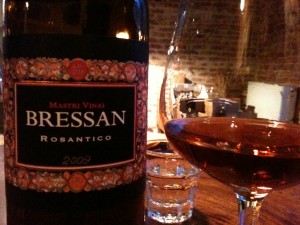 Appearance: Normally I would say “see the photos”, but since the photos i took were in a dimly-lit place, I will try and describe the color. It has more of a light-reddish-copperish color, than of a pure rosé like we might see from southern France. Like a pure extraction of fruit juice. Intriguing for sure. See photo
Appearance: Normally I would say “see the photos”, but since the photos i took were in a dimly-lit place, I will try and describe the color. It has more of a light-reddish-copperish color, than of a pure rosé like we might see from southern France. Like a pure extraction of fruit juice. Intriguing for sure. See photo 
Nose: Wild fruits (berries) and rose pedals, very intense. Hints of floral soap, yes soap.
Palate: Dry. Important to emphasize dry, as in none or very little residual sugar. Texture of a liquor, with the alcohol a bit noticeable but not enough to throw the wine out of balance. I think this aspect of the wine will integrate nicely in the coming years adding to its complexity. Super length and acidity giving this syrupy wine lots of freshness. Really very liquor-like in the texture. Like a syrup made of fresh berries. The after taste had mild yeasty hints, which I liked.
Although enjoyable now, will be enjoyable for years to come for sure. Goodbye today’s rosé and hello rosé for tomorrow!
]]>
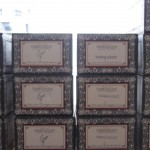
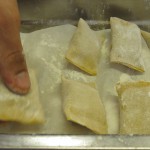 Event: Bressan Wine Maker Dinner
Event: Bressan Wine Maker DinnerRestaurant: Jacob’s Bar & Kjøkken
Date: Saturday, March 13th 2010
Host: Fulvio Bressan, Vinosseur, 213 W Wine Imports
I have done a producer profile on Bressan in past posts, but nothing I have written could have prepared me for such a down to earth warm person such as Fulvio. Energetic and outgoing, Fulvio entertained everyone at our table and the other tables as we made our rounds to introduce him to our guests. I thought I was going to have my work cut out for me with the translating from Italian, but it turns out that Fulvio’s grasp of English is very good, making my job a little easier. The turn out was better than anticipated with a completely full restaurant with even a few tables being turned.. for quaint little Bergen, this is quite a feat!
Bressan not only entertained the guests’ questions, he even managed to sneak over to the bar guests who stopped in after the local football (soccer) game and befriend them! Behind this outgoing, down to earth person, lies an amazing wine maker, even more amazing is his approach to viticulture. Although he is as natural as he can be, their is a lot of science going on here, especially when it comes to harvest. The effect that the harvest of healthy grapes has on the final wine is tremendous! In fact, harvesting even one day “too soon” or one day “too late” can make a significant difference on the final wine. (click on the images below to enlarge)
 Fulvio spoke of how much one or two days effect the maturity of the grape, what climate does to the maturation curve (sugar versus phenolic maturity), volatile acidity relating to date of harvest, and hours of light exposure effecting grape maturity. He even spent a few minutes discussing oxygen exchange differences between different size oak barrels, the smaller the barrel, the thinner the wall diameter, the greater the oxygen exchange (and oak influence). The most important thing to understand here is that most of his science, and the most important part of it, is out in the vineyards – especially when it comes to the exact date to harvest – probably the single most important. He also mentioned that the only thing he does out in the vineyards is the copper and sulfur treatment, but never after the 31st of July. And, he never harvests before it has rained, so that the grapes can be rinsed.
Fulvio spoke of how much one or two days effect the maturity of the grape, what climate does to the maturation curve (sugar versus phenolic maturity), volatile acidity relating to date of harvest, and hours of light exposure effecting grape maturity. He even spent a few minutes discussing oxygen exchange differences between different size oak barrels, the smaller the barrel, the thinner the wall diameter, the greater the oxygen exchange (and oak influence). The most important thing to understand here is that most of his science, and the most important part of it, is out in the vineyards – especially when it comes to the exact date to harvest – probably the single most important. He also mentioned that the only thing he does out in the vineyards is the copper and sulfur treatment, but never after the 31st of July. And, he never harvests before it has rained, so that the grapes can be rinsed.
Enough said, now on to the dinner and the pairings!
****
AMUSE BOUCHE
****
FIRST COURSE
PAIRED WITH
Comments: The delicate dried apricot aromas in the wine matched perfectly with the compote.
****
SECOND COURSE
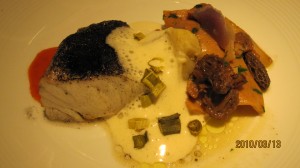
Baked Saithe with Blackened Leek, Crispy Spring Onion, Artichokes and Scallop and Mushroom filled Ravioli
PAIRED WITH
Comments: When I spoke to Fulvio on the phone about pairing his Pignol with a fish dish, he thought we were crazy. When he tasted the dish, he was stunned! The combination of fish, burned leeks and mushrooms created the link between the wine and the dish.
****
THIRD COURSE
PAIRED WITH
Comments: The pepper notes in this wine and good acidity paired especially well with the green lentils and liver
FOURTH COURSE
PAIRED WITH
Comments: Although I rarely use a dry red wine with cheese, this wine was great with the cheese and tomato sorbet (slightly sweet). We got mixed reviews on this dish. Many guests expected the “dessert” to be something sweet, rather this was an Umami filled dish which was for many of us at our table, one of the best pairings of the meal.
]]>
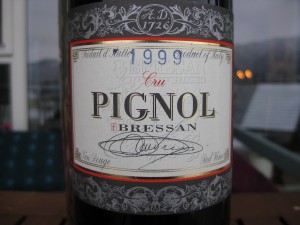 And along came the Pignolo grape, another very rare, refined, prestigious and indigenous grape of the Fruili-Venezia Giulia region in North-Eastern Italy. This grape has the potential to make “Cru” level wines, like Bressan’s Cru Pignol, a stunning example of what this grape can do when care is taken in the vineyards and the winery. According to Fulvio, the Pignol needs at least 8 years of aging to become a great wine, and after tasting his latest Pignol release, I would have to agree. At 10 years of age, this wine is just a baby. Drinking well now, but begging to be left alone for another ten.
And along came the Pignolo grape, another very rare, refined, prestigious and indigenous grape of the Fruili-Venezia Giulia region in North-Eastern Italy. This grape has the potential to make “Cru” level wines, like Bressan’s Cru Pignol, a stunning example of what this grape can do when care is taken in the vineyards and the winery. According to Fulvio, the Pignol needs at least 8 years of aging to become a great wine, and after tasting his latest Pignol release, I would have to agree. At 10 years of age, this wine is just a baby. Drinking well now, but begging to be left alone for another ten.
Soil Composition: Prevalently rocky, with a high presence of iron sesquioxides. Such a pedological characteristic, associated with the scarce endowment of organic substances and nutritive elements, induces a vigorous development – extremely moderate production, with positive repercussions for MACRO and MICRO components of the grape and its wine.
- Total surface area: 1.058 HA
- Planting year: 1991
- # vines/HA: 4630
- Sun exposition: Southern, with rows oriented Northwest-South
- Harvest: Physiologically correct, harvested by hand
Wine Making: Pignolo grapes brought to must, removed from their stalk and soft pressed, macerated over an extended period with principal fermentation along with their skins for 30 days, at a controlled temperature of 24C (75F). After racking, the wine undergoes a secondary fermentation for 40 days in stainless steel followed by at least 3 years aging in 2000 liter oak casks. Bottled at Spring’s end then stored in a temperature controlled warehouse for (circa) 15 months.
- Alcohol content: 13.38%
- Total acidity: 6.31 g/l
Date tasted: Saturday December 26th, 2009 12:02 (PM)
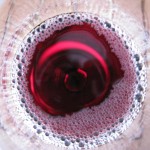
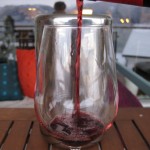 Appearance: Medium dark garnet red with some development showing. Medium to medium plus intense glow.
Appearance: Medium dark garnet red with some development showing. Medium to medium plus intense glow.
Nose: Medium intense wine with hints of white and rosé pepper. Wild berries. Hints of forest floor and some eucalyptus. Hints of dried blueberries and mineral. Floral with medium complexity now. May open up more.
Palate: Medium intense wine with wild berries, crushed pencil lead with hints of blueberries. Mild, elegant tannins with medium plus acidity. Very fresh and long with hints of musk, white pepper and mineral on the finish. Secondary aromas of blackberries and raspberries emerge after 20-30 seconds making this wine very complex. Extremely well-balanced and delicious. Very youthful even at it’s modest 10 years of age. Drink now or cellar for 10 more years.
]]>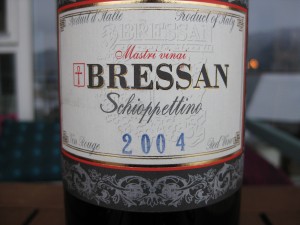 The Schioppettino is a red grape grown predominately in the Friuli-Venezia Giulia region of Italy. Also known as the Ribolla Nera, pills Schioppettino literally means “gunshot” or “little crack”. Records show that red wine made from the Schioppettino was used at marriage ceremonies back to 1282. The grape was nearly lost to extinction thanks mostly to the phylloxera epidemic. Today, Bressan is one of the few wine makers making wine from the Schioppettino grape.
The Schioppettino is a red grape grown predominately in the Friuli-Venezia Giulia region of Italy. Also known as the Ribolla Nera, pills Schioppettino literally means “gunshot” or “little crack”. Records show that red wine made from the Schioppettino was used at marriage ceremonies back to 1282. The grape was nearly lost to extinction thanks mostly to the phylloxera epidemic. Today, Bressan is one of the few wine makers making wine from the Schioppettino grape.
Soil composition: Calcareous mineral base, with high presence of iron sesquioxides. Such geological characteristics, associated with this scarce endowment of organic and other nutritional elements, forces the vines to a slow vegetative growth, resulting in an extremely low production, with an overall benefit to the MACRO and MICRO components of the grapes, and therefore the wines.
- Total surface area: 3.88 HA
- Planting year: 1982
- # of vines/HA: 3086
- Sun exposition: Southern, with rows oriented EAST-WEST
- Harvest: Permitted to slightly over-mature (so as to attain very high fixed acidity congenital to the species), harvested by hand.
Wine Making: Grapes are de-stalked and brought to must by way of soft-pressing; extremely long maceration with principal fermentation along with the grape skins, refrigerated with well water at a controlled temperature not exceeding 25C (77F). After racking, the wine undergoes an ulterior 35 days of fermentation. The wine is then stored in stainless steel tanks, followed by aging for at least 2 more years in 2000 liter oak casks. After bottling, groups of 500 bottles are placed in large chests, which are then stored in a temperature controlled warehouse for additional aging.
- Alcohol content: 13%
- Total acidity: 5.58 g/l
Date tasted: Saturday December 26th, 2009 12:02 (PM)
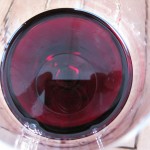
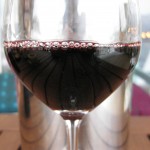 Appearance: Medium dark brick red. Very very slight development showing. Medium intensity.
Appearance: Medium dark brick red. Very very slight development showing. Medium intensity.
Nose: Very intense freshly ground black pepper. Blackberries and dark plums with mineral undertones. Floral and very intriguing. Hints of roasted meat. Forest floor, musk and wild fruit. Very complex and intriguing nose.
Palate: Very intense on the palate as well with aromas of black pepper, wild dark berries, musk and hints of red berries with a mineral background. Some pleasant dried fruit aromas as well. Medium tannins, medium to medium plus acidity carrying the wine to a long, very fresh finish. Very fresh and very drinkable. This has always been one of my favorite wines of Bressan.. Excellent with lamb!
]]>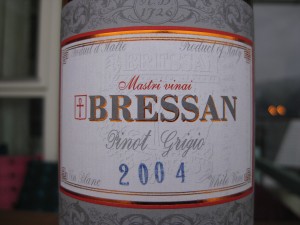 Soil composition: Calcareous mineral base, cost with high presence of iron sesquioxides. Such geological characteristics, clinic associated with this scarce endowment of organic and other nutritional elements, search forces the vines to a slow vegetative growth, resulting in an extremely low production, with an overall benefit to the MACRO and MICRO components of the grapes, and therefore the wines.
Soil composition: Calcareous mineral base, cost with high presence of iron sesquioxides. Such geological characteristics, clinic associated with this scarce endowment of organic and other nutritional elements, search forces the vines to a slow vegetative growth, resulting in an extremely low production, with an overall benefit to the MACRO and MICRO components of the grapes, and therefore the wines.
- Total surface area: 1.41 HA
- Planting year: 1990
- # of vines/HA: 4630
- Sun exposition: Southern, with rows oriented NORTHWEST-SOUTH
- Harvest: Physiologically correct, by hand
Wine making: Grapes are de-stalked and soft-pressed, with cold decanting of the must and the total elimination of the entire part decanted. 20-25 days cold fermentation. Subsequent slow fermentation of the fine lees in stainless steel tanks; then aging for 12-15 months before bottling. Bottles are placed in groups of 500 in large chests that are then stored in temperature controlled warehouses for additional aging.
- Alcohol content: 13%
- Total acidity: 5.20 g/l
Date tasted: Saturday December 26th, 2009 12:02 (PM)
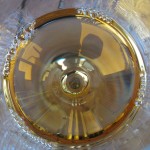
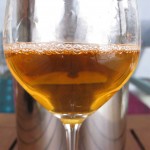 Appearance: “Ramato” – Copper-like color, but perhaps a bit lighter than the Verduzzo Fruilano with a tad more brownish tinge. Medium plus intense glow.
Appearance: “Ramato” – Copper-like color, but perhaps a bit lighter than the Verduzzo Fruilano with a tad more brownish tinge. Medium plus intense glow.
Nose: Less intense than the Verduzzo Fruilano and more “feminine”. Fresh apricots and orange peel. Hints of star anise and mineral. Medium complex
Palate: Medium intense wine with orange citrus, hints of apricot, star anise and mineral. Well-integrated alcohol, very fresh and drinkable. Very mild tannins, medium plus acidity with a long, mineral, fresh finish. One of the best Pinot Grigio’s I have ever tasted, if not the best.
Drinking very well now, but can be stored up to 5 years in my opinion. Another winner from Bressan…
]]>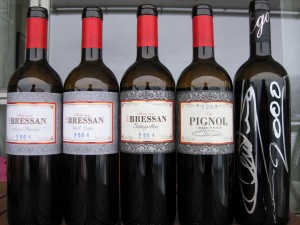 In Part I of the Bressan producer profile, I discussed in depth the philosophy of Fulvio Bressan. Now I will present some of his wines which I had the opportunity to taste. Bressan is an artisan wine producer making wine in extremely small quantities, between 0-50,000 bottles per year. They specialize in the production of indigenous grape varieties, including the wine being tasted for this tasting note.
In Part I of the Bressan producer profile, I discussed in depth the philosophy of Fulvio Bressan. Now I will present some of his wines which I had the opportunity to taste. Bressan is an artisan wine producer making wine in extremely small quantities, between 0-50,000 bottles per year. They specialize in the production of indigenous grape varieties, including the wine being tasted for this tasting note.
The Verduzzo (Friulano) grape is indigenous to Friuli, but can also be found in the Veneto. According to Fulvio, it is very rare to find dry versions of the wine made from this grape (only 2 or 3 other producers in Friuli make it dry). The Verduzzo grapes is unusual in that it has high tannins like you might find in a red wine. Therefore, if the grape is harvested too early, the tannins can be quite bitter and harsh, and therefore wine makers began adding sugar to the wine to make it sweet, thus masking the bitterness of the tannins. In Fulvio’s opinion (and in mine as well), a sweet wine will not be balanced when made in this way. Fulvio instead picks his grapes at the optimal ripeness (because he is patient), and vinifies the wine as a dry wine.
The first thing you notice when pulling the cork out of the bottle is the quality of the cork itself. Fulvio swears by the quality of his corks and says that if you ever get a corked bottle, simply return the cork and he will refund you.
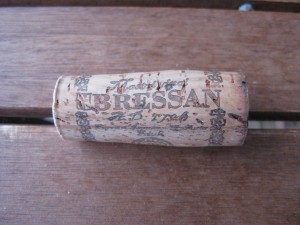 Soil composition: Calcareous mineral base, with high presence of iron sesquioxides. Such geological characteristics, associated with this scarce endowment of organic and other nutritional elements, forces the vines to a slow vegetative growth, resulting in an extremely low production, with an overall benefit to the MACRO and MICRO components of the grapes, and therefore the wines.
Soil composition: Calcareous mineral base, with high presence of iron sesquioxides. Such geological characteristics, associated with this scarce endowment of organic and other nutritional elements, forces the vines to a slow vegetative growth, resulting in an extremely low production, with an overall benefit to the MACRO and MICRO components of the grapes, and therefore the wines.
- Total Surface: 1.51 HA
- Planting year: 1990
- # of Vines/HA: 4630
- Sun exposition: Southern, with rows oriented NORTHWEST-SOUTH
- Harvest: slightly late, by hand
Wine making: The grapes are de-stalked and macerated with the skins for 48 hours. Cold-fermentation for 20-25 days, then transferred to 225-liter barriques (Slovenian I am told and most likely used since the oak was not dominant on this wine) where the wine stays on the fine lees for about 8 months. Then the wine is “re-united” and placed into stainless steel tanks where it remains for another 2-3 months. The wine is bottled at summers-end and placed in large chests containing 500 bottles each, then stored in a temperature-controlled warehouse for additional aging. The wine is released when Fulvio feels the wine is ready to be drunk.
- Alcohol content: 13.63%
- Total acidity: 5.45 g/l
Date tasted: Saturday December 26th, 2009 12:02 (PM)
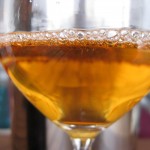
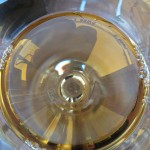 Appearance: ”Ramato (“Coppery” in Italian, and a term used in Fruili)” – ”Copper”-like color. High intensity glow
Appearance: ”Ramato (“Coppery” in Italian, and a term used in Fruili)” – ”Copper”-like color. High intensity glow
Nose: Intense aromas of mature fruit leaning towards peaches and apricots. Christmas-like spices and dried fruits with brandy-like hints (rancio?). Orange citrus emerging. Very fresh, complex and intriguing nose.
Palate: Intense wine with orange peel, some dried apricots and plenty of spices. Brandy-like aromas also on the palate (rancio?), yet fresh and persistent. Well-balanced with intense fruit, mild tannins, medium to medium plus acidity carrying the wine to a very long finish. Very dry. Alcohol slightly noticeable, but once the bottle has been opened for an hour or so, the alcohol will integrate based on my previous tastings of this wine. Would be great with food!
]]>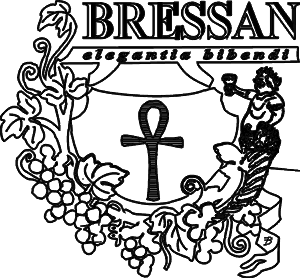 BRESSAN mastri vinai
Via Conti Zoppini, 35
34070 FARRA D’ISONZO (Gorizia)
Italy
Tel. +39 – 0481 – 888131
Fax +39 – 0481 – 889824
E – mail: bressanwines@tin.it
www.bressanwines.com
www.bressanwines.it
BRESSAN mastri vinai
Via Conti Zoppini, 35
34070 FARRA D’ISONZO (Gorizia)
Italy
Tel. +39 – 0481 – 888131
Fax +39 – 0481 – 889824
E – mail: bressanwines@tin.it
www.bressanwines.com
www.bressanwines.it
I haven’t done too many “producer profiles” so far, and I suppose that’s because I really have to believe in the philosophy of the producer before I feel compelled to write about them. Then, I really have to like the wines. I may have a favorite bottle, but overall, I tend to enjoy all of the wines the producer makes. Usually the wines will have a certain signature that says they all belong to a certain family – in this case we’re talking about the philosophy and wines of Mastri Vinai Bressan, and that signature is one of passion and patience. Patience enough to release a wine that, although is certainly age worthy, is actually ready to drink upon release. And this is why I have selected to write about Bressan.
The Bressan family owns about 20 hectares in the Friuili-Venezia Giulia appellation in North-Eastern Italy on the border to Slovenia. The first thing that struck me about this producer was of course the wines. Indigenous varieties that one does not taste every day, such as the Schioppettino, Pignol and Verduzzo Friulano. The second thing that struck me was the vintage of some of these wines which went back as far as 1999 (the latest release of the Pignol, for instance). The third thing that struck me was the philosophy of this producer. A philosophy very much in line with what I feel a wine producer’s philosophy should be.
The philosophy of the producer is very important to me. I focus mostly on wines that are organic, biodynamic and natural. It is not important to me if the producer is certified organic or biodynamic and I have said this before. After all, getting a certification is sometimes done for the wrong reasons. I am not excluding producers that ARE certified, I am just stating that an attitude and philosophy are in my opinion more important.
Fulvio Bressan says the following: ” I am not ‘organic’, even my own personal rules impose conditions in the vineyard and wine-cellar that are more severe than those of various ‘certifications’ “. He adds ” I am not bio-dynamic because I know unfortunately that the rules can be superseded by fashion and I know that nothing is easier than imposing rules and then breaking them, thus profiting from the naiveté of others… ” And, goes on to say ” The majority of wines produced today around the world are made mediocre, deprived of character, standardized, unable to challenge Time due to the indiscriminate use of chemicals both in the vineyard and the wine-cellar. This method of working deadens the traces of the grapevine, the features of the territory and the personality of the producer “. You can read more about his approach and philosophy here. It’s very interesting and worth a read!
And now on to the vines and wines. The wines of Bressan are made using only proprietary grapes. He does not sell or buy grapes. In fact, if the vintage is not a good one, Bressan chooses to simply let his grapes hang on the vines and fall to the floor and back into the soil in which they came. This way, nobody else can say they produce wines with the grapes of Bressan. His neighbors think he’s crazy, but he feels if his name is going to be on the bottle, it needs to be representative of his values. He says he will probably never get rich, but he will always be able to look into the eyes of people he has in front of him.
All the work they do in the vineyards and in the wine cellar is done with the maximum respect for nature, the grapes and the people who drink their wines (“wine should be a medicine not a poison as in many cases”). Here are the rules they have always followed:
- Manual selection of the vines and preferential use of indigenous varieties (cloning and all forms of genetically-modified organisms are forbidden)
- Pruning and removal of shoots is performed exclusively by hand
- Personal cultivation of the vineyard without the use of synthetic chemical substances, respecting vine and its natural cycles (total exclusion of herbicides and/or fungicides and/or pesticides)
- Exclusive use of natural fertilizers, from vegetables or from the barn, or else none at all
- Irrigation is forbidden even as relief, as water has always diluted the aromatic wealth and intensity of the wine
- The harvest is done manually to obtain perfectly healthy and mature grapes (no premature harvesting)
- Fermentation is obtained thanks to indigenous yeasts naturally present in the grape, absolutely excluding the use of synthetic industrial yeasts.
- No sulfurs anhydrides are added to the must, nor are other additives / chemicals (sulfurs anhydrides might be added only in small quantities at the moment of bottling and in any case in quantities that are lower or equal to biological certification)
- The use of biological and/or chemical aromas is forbidden
- Maturation of the wine in its own “fine lees” up to bottling
- No filtration (a practice which in any case always impoverishes and sterilizes the wine)
- Exclusive use of cork, rigorously limited to natural single pieces, so that each wine will have Time as its best ally
- Rigorously manual labeling (… each bottle is a unique creature… )
I will do complete tasting notes on 5 of Bressan’s wines over the next few days, so check back for some exciting wines and tasting notes!! Happy Holidays!!
(I am sorry for the quality of the photo’s in this post. Since I am not a photographer, I should really apologize at the beginning of every post, but the photos in this post are especially low quality – blamed on the settings being incorrect on my “wonderful” camera phone. Oh, and although this post seems long, it’s mostly full of pictures to entertain you)
Tuesday November 3rd, 2009
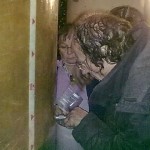
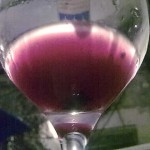 Our goal was to reach Jean-Pierre Robinot sometime in the afternoon, but when visiting with natural wine makers, it’s really best not to have a schedule! We left Griottes quite late, and it was at least a 2 hour drive to Robinot’s, so we didn’t arrive until around 2200 (10pm) that evening. Nevertheless, we were greeted by the very energetic Jean-Pierre and his wonderful wife Noella. He immediately took us into the cellar where we began to sample his 2009 harvest of Pineau d’Aunis right from the fiberglass containers where they had just finished fermenting. We started with the 2009
Our goal was to reach Jean-Pierre Robinot sometime in the afternoon, but when visiting with natural wine makers, it’s really best not to have a schedule! We left Griottes quite late, and it was at least a 2 hour drive to Robinot’s, so we didn’t arrive until around 2200 (10pm) that evening. Nevertheless, we were greeted by the very energetic Jean-Pierre and his wonderful wife Noella. He immediately took us into the cellar where we began to sample his 2009 harvest of Pineau d’Aunis right from the fiberglass containers where they had just finished fermenting. We started with the 2009 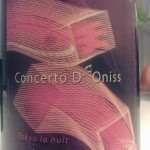
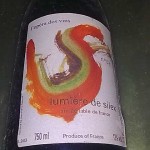 Concerto d’Oniss which was fermented using purchased grapes from farmers (and friends) who have the same values and ideals in the vineyards as he does. This “basic” wine of his will be bottled straight from the fiberglass tank and spend no time in any other container. Wines made from purchased grapes go into bottles labeled under the product line “L’Opera des Vins”. This is one of my favorite of Robinot’s wines due to the clean, precise fruit and no oak influences.
Concerto d’Oniss which was fermented using purchased grapes from farmers (and friends) who have the same values and ideals in the vineyards as he does. This “basic” wine of his will be bottled straight from the fiberglass tank and spend no time in any other container. Wines made from purchased grapes go into bottles labeled under the product line “L’Opera des Vins”. This is one of my favorite of Robinot’s wines due to the clean, precise fruit and no oak influences.
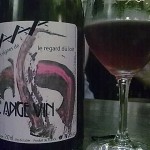 We also tasted the just finished fermenting wine from grapes growing in Jean-Pierre’s own vineyards which will for the most part spend some time in oak before being bottled with labels indicating that the grapes were his own by the product line “Les Vignes de L’Ange Vin (L’Ange Vin for short)”. These were so stunning that I feel confident when I say that the 2009 vintage for Jean-Pierre Robinot will be top!
We also tasted the just finished fermenting wine from grapes growing in Jean-Pierre’s own vineyards which will for the most part spend some time in oak before being bottled with labels indicating that the grapes were his own by the product line “Les Vignes de L’Ange Vin (L’Ange Vin for short)”. These were so stunning that I feel confident when I say that the 2009 vintage for Jean-Pierre Robinot will be top!
After a few quick hours in the cellar tasting the new wines, we retreated back to the home of Jean-Pierre and Noella, where Noella started to cook a wonderful home-cooked meal which consisted of vegetables from their “natural garden”. Grown in the same way their grapes are grown, the vegetables are left to grow “wild” without the use of any chemicals nor fertilizers. We started dinner at around 130am, which I must admit was probably the latest dinner I had ever had! Jean-Pierre’s energy never faltering!
Jean-Pierre’s labels for his wine bottles are reproductions of his full-size paintings which are scattered through-out the Robinot home. It’s obvious that when Jean-Pierre is not hard at work with his vine and wine, he is painting, his other passion. His labels are all different, unique and my opinion, very beautiful.
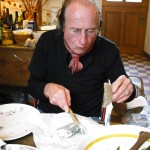
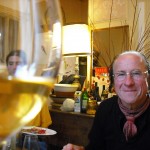 The next day, we had a quick lunch together as Jean-Pierre hurriedly ate so that he could be off to great a small group of Japanese wine tourists who were looking forward to tasting Robinot’s wonderful wines. It seems that the Japanese really appreciate and understand natural wines. After lunch, Noella took us to see the vineyards, and I have to say, they were truly a sight. Now I have seen many vineyards including biodynamic ones, but these had to be the most natural vineyards I have ever seen. The vineyards that in my opinion were the most stunning, were his old-vine Pineau d’Aunis. These 100 year-old+ vines where growing in a field of weeds, they were covered in moss and ivy and looked absolutely at home there. She mentioned that the vineyards were the laughing-stock of his conventional neighbors, yet produced the greatest grapes in the area by far. When walking through the vineyards, I couldn’t help but notice the way the soil was soft and just gave way under the weight of my body. The soil was very much alive, and the bugs and insect in the area were proof of this. By contrast, when we walked through the vines of the neighboring vineyards, it was like walking on cement. The soil was extremely packed and dead. Not a bug in sight. Soils that have been killed by the use of chemicals take years and years to recover. I am told that even 10 years after converting the agriculture to organics, the soil is still not completely alive.
The next day, we had a quick lunch together as Jean-Pierre hurriedly ate so that he could be off to great a small group of Japanese wine tourists who were looking forward to tasting Robinot’s wonderful wines. It seems that the Japanese really appreciate and understand natural wines. After lunch, Noella took us to see the vineyards, and I have to say, they were truly a sight. Now I have seen many vineyards including biodynamic ones, but these had to be the most natural vineyards I have ever seen. The vineyards that in my opinion were the most stunning, were his old-vine Pineau d’Aunis. These 100 year-old+ vines where growing in a field of weeds, they were covered in moss and ivy and looked absolutely at home there. She mentioned that the vineyards were the laughing-stock of his conventional neighbors, yet produced the greatest grapes in the area by far. When walking through the vineyards, I couldn’t help but notice the way the soil was soft and just gave way under the weight of my body. The soil was very much alive, and the bugs and insect in the area were proof of this. By contrast, when we walked through the vines of the neighboring vineyards, it was like walking on cement. The soil was extremely packed and dead. Not a bug in sight. Soils that have been killed by the use of chemicals take years and years to recover. I am told that even 10 years after converting the agriculture to organics, the soil is still not completely alive.
After our vineyard tour, we met with Jean-Pierre in his cellars to taste from the barrels. We tasted at least 40 wines ranging from his top reds, base whites (Chenin Blanc) to some of his sweet wines and even some Vin-Jaune-like wines that had been in barrel for 5 years and more and had developed the wonderful flor that develops in the wines of Jerez and the Jura. Jean-Pierre left us to run off to Paris for the weekend, where we were to meet again on Saturday night for dinner!
We spent two nights at the Robinot’s modest home where were fed only vegetables from their garden and meat from friends who had raised the animals in a natural environment. For their hospitality, I am completely grateful. They were extremely gracious hosts. Simple, yet complex people who truly lived off the land and who enjoyed every moment.
My final thoughts about the wines of Robinot are that his wines are dark, haunting, complex, while maintaining a certain freshness and drinkability which I find too many wines lack. His wines are not easy to understand and are full of mystery, as are the Robinot’s
]]>